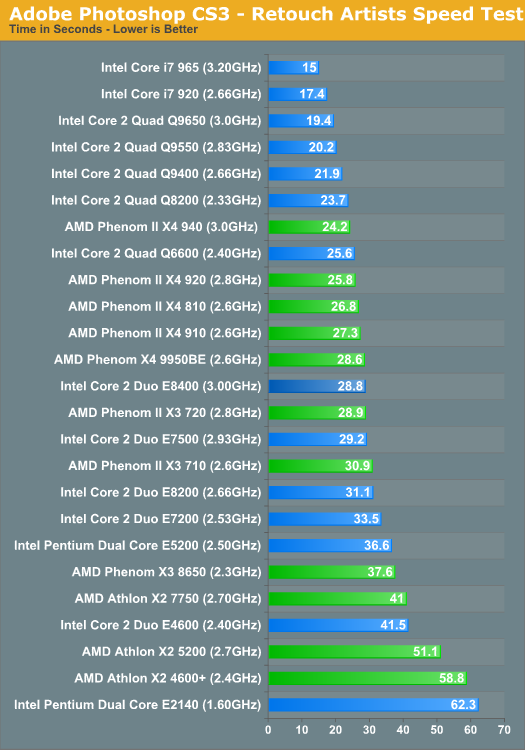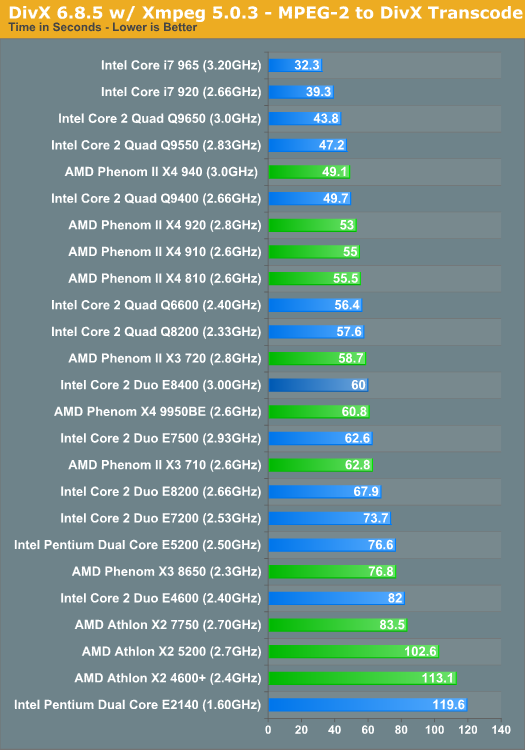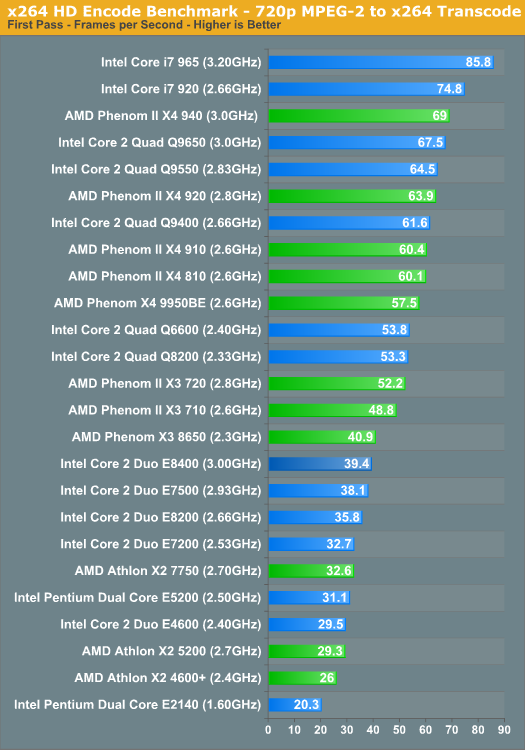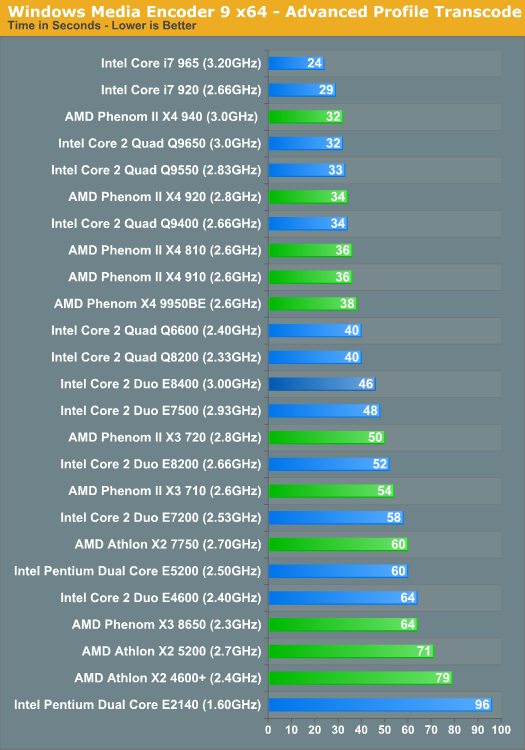The Phenom II X4 810 & X3 720: AMD Gets DDR3 But Doesn't Need It
by Anand Lal Shimpi on February 9, 2009 12:00 AM EST- Posted in
- CPUs
Adobe Photoshop CS4 Performance
To measure performance under Photoshop CS4 we turn to the Retouch Artists’ Speed Test. The test does basic photo editing; there are a couple of color space conversions, many layer creations, color curve adjustment, image and canvas size adjustment, unsharp mask, and finally a gaussian blur performed on the entire image.
The whole process is timed and thanks to the use of Intel's X25-M SSD as our test bed hard drive, performance is far more predictable than back when we used to test on mechanical disks.
Time is reported in seconds and the lower numbers mean better performance. The test is multithreaded and can hit all four cores in a quad-core machine.

While our Photoshop CS4 benchmark clearly prefers Intel's CPUs, the results aren't so clean cut. The entire Phenom II 800 and 900 lineup falls short of their competitors, but the Phenom II X3 720 can equal its rival: the Core 2 Duo E7500. It's slower than the more expensive E8400, but it's at least competitive.
This is where AMD has some potential to do well. As a result of its larger die, the 720 has one more core than Intel's svelte Core 2 Duos. In well threaded applications, the X3 could come out ahead.
DivX 8.5.3 with Xmpeg 5.0.3
Our DivX test is the same DivX / XMpeg 5.03 test we've run for the past few years now, the 1080p source file is encoded using the unconstrained DivX profile, quality/performance is set balanced at 5 and enhanced multithreading is enabled:

Both the Phenom II 900 and 800 series parts are competitive here. The Phenom II X3 720 actually beats out both competitors here, the E7500 and E8400 are close but no faster than the 720. Here's a benefit of that extra core at work.
x264 HD Video Encoding Performance
Graysky's x264 HD test uses the publicly available x264 codec (open source alternative to H.264) to encode a 4Mbps 720p MPEG-2 source. The focus here is on quality rather than speed, thus the benchmark uses a 2-pass encode and reports the average frame rate in each pass.

The first pass of the x264 benchmark is actually an analysis pass, the real encoding is done in the second pass. There are apparently quite a few unaligned cache accesses in this test which severely penalize the Core 2 processors; Core i7 is unaffected. Because of the unaligned cache access performance penalty, AMD owns the price/performance comparison here.

The actual encode workload is much more competitive. The Phenom II 800 and 900 series chips cluster around each other, remaining competitive but not really any faster than the equivalently priced Core 2 Quads. The Phenom II X3 720 continues to be faster than its competitor thanks to its core count advantage.
Windows Media Encoder 9 x64 Advanced Profile
In order to be codec agnostic we've got a Windows Media Encoder benchmark looking at the same sort of thing we've been doing in the DivX and x264 tests, but using WME instead.

Here we've got, once again, a competitive AMD but there's something very interesting going on with the triple core 720. WME9 doesn't make use of the third core as it is hard coded to use powers of 2 for the number of processor cores. There are some applications that will exhibit this sort of behavior, although in our testing the numbers are limited. With its third core out of the picture, the 720 is slower than Intel's Core 2 Duo E7500.










77 Comments
View All Comments
Griswold - Monday, February 9, 2009 - link
"We're in the midst of a price war folks, and at a time when the global economy is looking a little shaky this actually works very well for us. Let's recap what's happened."That works very well for us until AMD, despite having a good product portfolio (this includes video cards), goes belly up thanks to this worldwide recession (a little shaky? Where have you been the last couple of months!?).And then what? Back to moon prices courtesy of Intel?
I hope not, but fear the worst. :(
lplatypus - Monday, February 9, 2009 - link
Why does the Ph II 940 system use only 4W more than the 810 at load? This is not consistent with TDPs (125W vs 95W). The HEXUS.net review found a 23W difference under load. Is something wrong here?Axloth - Monday, February 9, 2009 - link
I'd love to see detailed test of impact of cache size per core, because test results in this review are really weird. Something like x4 910 vs x4 810 vs x3 710. Pretty please with sugar on top...ET - Monday, February 9, 2009 - link
Needs more comprehensive testing, period. The results look really strange sometimes. Not only did the 810 sometimes outperformed the 910 significantly, but the 710 consistently beat the 910 in the gaming tests.(So far -- and I haven't read other reviews -- the 710 is looking like a good candidate to replace my aging X2 3800+.)
RadnorHarkonnen - Monday, February 9, 2009 - link
From the rumors ive seen in the web, this will be a pretty cheap cpu.Myt little brother is crying for My 4800 X2 (he always get free upgrades) with 4Gb DDR2.
Just one question, With a Stock VID 1.325 to 1.55 isn't that a little bit aggressive (even with good air cooling), for everyday operation ? I was hoping for a OC up to 3.6Ghz in decent voltage. 3.8Ghz Would be very good, but the voltage seems somewhat too large for day-to-day operation.
Thanks for reading, and replying if you have the time, of course.
Gary Key - Monday, February 9, 2009 - link
On our samples, starting around 3.5GHz you really had to ramp the Core VID. 3.6 required about 1.45V in the BIOS, with droop it was around 1.4375V real on this board. If the retail chips follow the 940, then I would say around 1.425V should be realistic for 3.6GHz on the right board. 1.55V is not outside of AMD's spec and is the limit they have found for air cooling. It is about the same limit we have noticed also for the most part, but these chips are designed to take a lot voltage if you keep them properly cooled.RadnorHarkonnen - Monday, February 16, 2009 - link
I'm already checking prices and availability for this hardware. I'll check the speed bump and the temp bump between 3.5 and 3.6. Thanks for the info Gary.duploxxx - Monday, February 9, 2009 - link
most run 3.4 ghz already on stock vcore@review, you state that there is no performance difference between ddr2-ddr3 but you didn't show anything? Anyhow official statement from AMD is that the ddr3 part bios is not fully ready yet, so I hope you will do a full review later.
Gary Key - Monday, February 9, 2009 - link
"@review, you state that there is no performance difference between ddr2-ddr3 but you didn't show anything? Anyhow official statement from AMD is that the ddr3 part bios is not fully ready yet, so I hope you will do a full review later."AMD told us a couple of weeks ago to concentrate on performance with the AM2+ boards since the AM3 BIOS releases were immature. I received several BIOS releases last week for our AM3 boards and felt safe enough to display numbers with them in the OC section today.
We are still testing and will have comparisons up in the near future. That said, we still have a list of requests back to the motherboard companies to fix. For the most part now, the AM3 boards are usable and clock well. I figure another BIOS spin or two and they should be good to go.
Also, in a best case scenario, AMD had performance improvements of 5% at best in memory bandwidth limited benchmarks with DDR3. Things might change with the 945 hits in a couple of months, but on these processors, there really are not any differences between DDR2 and DDR3 at this point.
Kaleid - Monday, February 9, 2009 - link
Power consumption and framerates at the max stable overclock?